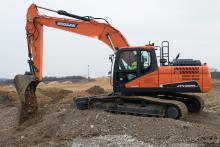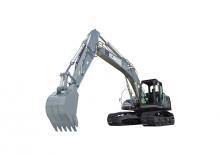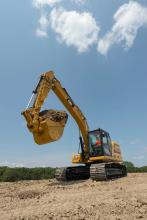The crawler excavator segment accounts for a substantial portion of total sales of construction machines. With this in mind, it is no surprise that this is a market segment for which manufacturers prioritise a significant proportion of their research and development budgets. Wheeled loaders, while not selling in quite such large numbers as crawler excavators, are also important machines for manufacturers.
Tougher legislation in Europe and the US has resulted in manufacturers utilising more sophisticated diesel engines in recent years, reducing exhaust emissions as well as noise. Environmental awareness has proliferated worldwide, while concerns over fuel costs have also had an effect on construction equipment manufacturers and the direction they are choosing in their machine designs.
While diesel engine firms have delivered new units that meet the latest emissions requirements as well as offering lower fuel consumption, the benefits of these new generation power units have been further boosted by new generation, electronically-controlled hydraulics.
Some firms have opted to further lower fuel costs for customers. And one of the fruits of this exercise has been the introduction of the hybrid excavator. While several firms developed hybrid excavator prototypes,
Other firms have been keen to offer their own hybrid alternatives, with
The firm claims to have been at the forefront of hybrid technology since 1999 when work on hybid excavators began, and says that the machine benefits from two power systems. It has an efficient Stage 4 (Tier IV) Hino Motors turbocharged diesel engine producing 117kW (2000rpm), coupled to which is a new and larger Kobelco generator-motor. A key feature is the use of a large-capacity lithium-ion battery, providing an effective power-assist during operation, via the new generator-motor.
This system can deliver up to 25kW of power-assist, which reduces engine load at peak operation, while also improving fuel efficiency. The new lithium-ion battery can also store more electrical power than competing systems according to Kobelco. This feature in turn ensures that the all-electric swing motor delivers a higher performance. This new swing motor helps to lower engine load as it is not directly linked to the hydraulic system. In addition, the new swing motor has an effective regenerative function, providing recharging to the lithium-ion battery during the swing deceleration process.
The machine’s improved fuel efficiency is said to deliver a greater working efficiency, while also reducing its carbon footprint. However, the firm claims that the SK210HLC-10 also delivers high productivity for its size class. For example, the model’s work in H-mode with an increased torque setting is said to deliver around 7% greater digging volume over a conventionally-powered equivalent (SK210LC-9).
Komatsu is not complacent about the strong position it holds in the market with its hybrid excavators and is now offering additional models. The latest is a narrow configuration version of the HB365LC/NLC-3, its 36tonne hydraulic hybrid excavator. The firm says that this has been designed to offer high lift capacity and great stability, with fast swing performance.
The machine features an EU Stage IV engine and ultra-low noise levels. It is equipped with the same proven SAA6D114E‐6 engine 202kW as the PC360LC‐11, with up to 53kW of electric power supplied by the innovative Komatsu Hybrid system.
The system works by converting kinetic energy generated during the swing-braking phase to electricity. This is sent through an inverter and stored in the Komatsu Ultra Capacitor. It is then discharged to power upper structure swing, when accelerating under workload conditions, as well as assisting the engine as commanded by the hybrid controller. The reserve power stored by the hybrid system helps the machine at peak times during the operating cycle, maximising machine performance.
Other benefits of the HB365LC/NLC-3 include a low noise, high comfort cab with good all-round visibility. Machine working noise is further reduced due to optimised engine control and fan‐clutch systems.
Other manufacturers are sharpening up their excavator offerings also, although with more conventional models.
The Doosan D-ECOPOWER system combines new engine technology with advanced features and is said to increase performance and lower the total cost of ownership for customers. In all of the latest generation excavators from Doosan, the combination of high pressure common rail fuel injection engines with the company’s Electronic Control Unit has served to optimise performance and achieve maximum fuel efficiency.
The D-ECOPOWER technology utilises an electronic pressure-controlled pump within a closed centre hydraulic system to accomplish increases of up to 26% in productivity and up to 12% in fuel consumption improvements, depending on the mode selected. A closed centred main control valve minimises pressure loss, while the electric pressure-controlled pump manages and optimises engine power. The system uses nine sensors to detect the amount of hydraulic oil for a specific task and meter the quantity of fluid required, improving efficiency. Software electronically reproduces the full benefits of an open centre hydraulic system with little energy loss. The hydraulic system and engine are optimised and synchronised, further reducing losses within the system. The system is said to offer more feedback and improved machine control and less operator fatigue.
The DX490LC-5 and DX530LC-5 are both powered by the
The DX490LC-5 and DX530LC-5 excavators are said to suit heavy-duty work such as large-scale earthmoving, moving rock, demolition, secondary breaking, and loading haulers for quarrying, highway, aggregate, demolition and general construction projects.
The service allows owners and dealers to remotely monitor and communicate with Doosan machines via the DoosanConnect telematics website. The DoosanConnect system provides comprehensive information about machine performance through either satellite or mobile networks.
Similarly, the HMK 145 LC SR crawler excavator also has the Opera Control System and a tilting cabin for easy and fast servicing access to hydraulic components. Both machines are said to offer high performance and low fuel consumption for their respective weight classes.
The 13tonne machine is also available in a second standard configuration, the HX130 LCRD, which includes a dozer blade. The HX130 LCR excavator is powered by a 55kW Perkins Tier 4 Final/Stage IIIB-compliant diesel, with a DPF system.
The LCR model has a standard operating weight of 12.9tonnes, while the LCRD model’s standard operating weight is 13.56tonnes. It achieves a maximum dig depth of 5.57m and maximum digging reach of 8.2m, and is equipped with a standard 0.59m³ capacity, by a 1.03m-wide bucket.
Komatsu is introducing its PC228USLC-11 short tail excavator. It is said to enable an improved lifting capacity of 21% and a reduction in fuel consumption of 6%. It is also intended to provide improved operator comfort, increased safety features and low in-cab noise levels. The PC228USLC-11 has operating weights from 23-24tonnes depending on specification, with power from a Stage IV engine that is said to optimise performance, reduce emissions and provide advanced diagnostic capability. In addition, a Selective Catalytic Reduction system has been integrated to further reduce NOx emissions using the AdBlue additive.
Meanwhile for the wheeled loader segment, Doosan’s new DL280-5 wheeled loader is the latest unit in the high-performance 12-model wheeled loader range of operating weights from 12-35 tonnes. The front lift arm of the DL280-5 is powered by a closed centre hydraulic system with a 210litre/min axial piston pump for maximum hydraulic performance. This saves fuel and extends the lifetime and reliability of vital components, says the company.
The DL280-5 features Z-bar kinematics with a simple lifting piston system designed for heavy-duty applications. The breakout force of 145kN is combined with a constant bucket angle that is maintained throughout the range of movement. Bucket angles are also optimised in the travelling position and at ground level. The lift arm benefits from an automatic load isolation system (LIS), which reduces material spillage at speed and is fully adjustable.
The DL280-5 is powered by the 5.9litre Doosan DL06 diesel engine which provides high torque, performance and durability. Power is managed by three working modes - ECO, Normal and Power - to ensure optimum performance for the tough work conditions with fuel efficiency.
As standard, an auto shut-down reduces the idle time of the engine, to prevent the over-consumption of fuel and wasted operating time. In common with the five larger Doosan wheeled loaders - the DL300-5, DL350-5, DL420-5, DL450-5 and DL550-5 - the DL280-5 has a wide range of new safety and ergonomic features as standard.
Other existing features for the loader models include the high comfort cab, powerful Doosan and Scania Stage IV engines, smooth and responsive hydraulics, ZF powertrains, axle cooling and auxiliary hydraulic connections. As in the previous DL-3 range, most of these features are standard on the DL-5 wheeled loaders and many have been developed to optimise fuel efficiency.
The DL300-5 and DL350-5 wheeled loaders are powered by the Doosan DL08 6-cylinder diesel engine, with an output of 202kW at 1800rpm. The DL420-5 is powered by the Scania DC13 6-cylinder engine producing 254kW at 1800rpm. The DL450-5 and DL550-5 are also powered by the DC13 engine producing 257kW and 283kW respectively, at 1800rpm.
Providing high torque at low rpm and up to a 10% reduction in fuel consumption, the Doosan and Scania engines meet Stage IV emissions regulations without the need of a diesel particulate filter (DPF), through the use of cooled exhaust gas recirculation (EGR) and selective catalyst reduction (SCR) aftertreatment technologies.
From Italian firm
VF 4.63H is equipped with a redesigned linkage for full breakout force interchangeability. It is said to offer stability via its oscillating rear axle. The cab provides all-round visibility with soundproof technology and anti-vibration rubber shock to reduce noise inside.







